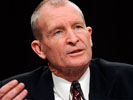
While mainstream media and national security wonks this week fixated on intelligence director Dennis Blair’s remarks about the threat of cyber attacks and the administration’s policy on targeting American terrorists during his briefing for the House, other shifts in this administration’s understanding of national security went largely unnoticed.
In particular, the administration’s point man on national security and intelligence included in this year’s global threat assessment a section devoted to “mass killings” – a “persistent feature of the global landscape,” the report said. Though the actual substance of the brief section is not groundbreaking for those attuned to civilian atrocities committed around the world, the inclusion of the term is significant, signaling a worldview that defines national security threats in a broader, more global framework.
The section states:
“Looking ahead over the next five years, a number of countries in Africa and Asia are at significant risk for a new outbreak of mass killing…Among these countries, a new mass killing or genocide is most likely to occur in Southern Sudan.”
By linking U.S. security concerns and mass killings, the administration has also changed the policy outlook toward genocide and civilian atrocities—as national security threats rather than just humanitarian concerns. Going beyond the moral and legal arguments found in the “responsibility to protect” doctrine, which argues that the international community has the responsibility to protect populations suffering from genocide, mass killings, or human rights violations, the administration has provided a self-interested rationale for engaging in, or even just caring about, the plight of civilians on the other side of the world.
The inclusion of mass atrocities in the threat assessment is also encouraging for many who felt that the blueprint produced by the Genocide Prevention Task Force, convened by the U.S. Holocaust Memorial Museum, American Academy of Diplomacy, and the U.S. Institute of Peace, held great promise to set the United States on a path to help avert crises and human suffering. As the museum noted in a recent blog post, Blair’s statement fulfills a recommendation made by the task force in 2008: "The director of national intelligence should initiate the preparation of a National Intelligence Estimate on worldwide risk of genocide and mass atrocities."
Though this doctrinal shift may not translate right away into noticeable changes in the way policy is implemented, it is a significant move toward recognizing the interconnectedness of global conflicts and the exigency of ending mass killings and human rights violations in the world. When they’re ready to start, we’ve got some suggestions of where and how.
Photo: Director of National Intelligence Dennis Blair (AP)

